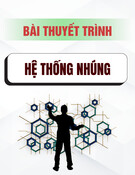Special Issue
JOURNAL OF SCIENCE AND TECHNOLOGY DONG NAI TECHNOLOGY UNIVERSITY
31
ADVANCING RAILWAY SAFETY AND EFFICIENCY DEVELOPMENT OF A HUMAN-FOLLOWING TRANSPORT ROBOT
Dong Nai Technology University *Corresponding author: Sang Van Nguyen, sangnv@dntu.edu.vn
Sang Van Nguyen*
GENERAL INFORMATION
Received date: 17/03/2024
Revised date: 16/05/2024
Accepted date: 04/07/2024
KEYWORD
Human-following technology;
ensuring
Railway safety;
Railroad worker collaboration;
Transport robot.
ABSTRACT This study addresses the critical need to enhance safety measures and accident prevention for railway workers while improving the overall work environment within the railway industry. Recognizing the challenges posed by railway work environments, characterized by heavy equipment and tasks involving the transportation of substantial loads, the objective is to develop a cutting-edge transport robot capable of autonomously carrying heavy loads and collaborating with railway workers. The transport robot is designed to follow seamless autonomously, railway workers collaboration while prioritizing safety. Equipped with sensors for real-time object detection, it automatically halts when workers or obstacles are detected within close proximity, enhancing worker safety. Developed on the ROS 2 platform for seamless integration of hardware and software, and utilizing the YOLOv5 model for precise object detection, the transport robot is poised to establish a secure and efficient work environment for railway workers. Through the implementation of these technologies, this study aims to revolutionize railway operations, enhancing convenience, efficiency, and safety for all involved stakeholders.
1. INTRODUCTION
The crucial railway industry,
enhancements in
(Zhu et al., 2022). Railway work environments are characterized by the presence of a diverse array of heavy equipment and tools, often necessitating the frequent transportation of substantial loads. These tasks not only pose inherent risks to the safety of workers but also impede operational efficiency, calling for innovative solutions to address these challenges effectively (Choi et al., 2020; Petrov et al., 2020). for transportation and commerce, is unfortunately marked by a persistent occurrence of safety accidents involving railroad workers. These incidents underscore an urgent need for comprehensive safety measures and accident prevention strategies to safeguard the well-being of railway workers and improve the overall work environment
JOURNAL OF SCIENCE AND TECHNOLOGY DONG NAI TECHNOLOGY UNIVERSITY
Special Issue
32
of
research
objectives;
avoiding
The contents are presented in this section research context, such as: background, importance of the research, literature review, identification problems, indication of the research’s novelty, and lengthy, research detailed presentations or just listing and summarizing previous studies (Chebotareva et al., 2020).
Figure 1. Robot Design Configuration
2. METHODOLOGY
2.2. Crafting the Robot's Software
2.1. Designing the robot's hardware
to
the
integration
smooth
between
also
enhances
agility
the
Simultaneously, considerable effort was dedicated software designing architecture of the transport robot system. Leveraging the ROS 2 platform, the software to framework was meticulously crafted and ensure interoperability hardware components and software modules. ROS 2 facilitates efficient communication, data exchange, and task coordination within the robot system (Song et al., 2023).
The initial phase of the project involved meticulous design considerations for the hardware aspects of the transport robot. Energy efficiency was prioritized, leading to the development of a lightweight frame. This choice not only reduces energy consumption but and maneuverability of the robot. Furthermore, the construction included robust structures and connectors to enable flexible loading and modular assembly and disassembly. These features ensure adaptability to various tasks and facilitate seamless collaboration with operators. (Shashank et al., 2022)
the
The operating system of the transport robot is based on Linux Ubuntu 20.04, providing a stable and reliable foundation for software operations. The software stack functionalities, various encompasses protocols communication including implemented in Python, control algorithms for keyboard and joystick inputs, motor connectivity logic, among others. These software components work synergistically to enable precise control and coordination of the in response to transport robot's actions environmental stimuli and user commands (Toan et al., 2023).
The computational core of the robot is powered by the NVIDIA Jetson Orin NX single board computer, chosen for its high performance and efficiency. Additionally, the robot is outfitted with a depth camera and LiDAR sensors to enable accurate perception of its surroundings, facilitating near and long- range object detection. This sensor suite environmental necessary provides awareness for the robot to make informed decisions in real-time (Li et al., 2023; Toan et al., 2023).
Special Issue
JOURNAL OF SCIENCE AND TECHNOLOGY DONG NAI TECHNOLOGY UNIVERSITY
33
Figure 3. Human-Following Robot
Figure 2. Configuration of the Following Robot System
focused Hardware
3. DEVELOPMENT OF ROBOT FUNCTIONALITY
on development realizing the designated functionalities outlined in the design phase. The robot's payload capacity was optimized to carry loads ranging from 20kg to 30kg, balancing utility and maneuverability. Additionally, safety features, such as the automatic halt upon detecting workers or obstacles within a certain distance, were implemented to mitigate potential hazards in the work environment. Figure 3 shown a visual representation of the human-following robot, showcasing its sleek design and integrated sensor suite.
4. RESULTS
The development of human-following and involved a safety driving capabilities comprehensive approach. Prior task to initiation, the robot establishes camera node connections and activates object detection using the YOLOv5 model. This model, recognized for its accuracy and efficiency, enables real-time identification and tracking of relevant objects, such as railway workers and obstacles.
The development efforts culminated in the successful realization of the transport robot, equipped with advanced human-following and safety driving capabilities. The integration of hardware and software components, as well as the implementation of sophisticated sensor technologies, enabled the robot to operate effectively in railway work environments.
To evaluate the performance of
Utilizing ROS 2 based real-time vision sensor data, the robot continuously measures distances to objects in its vicinity. When railway workers are detected in front of the robot, it dynamically adjusts its trajectory to follow the closest person at a consistent speed, facilitating seamless collaboration. However, if workers or obstacles are detected within a predefined safety distance of 1 meter in front of the robot, it triggers an immediate halt to ensure worker safety.
the transport robot, extensive simulations were conducted. These simulations focused on various scenarios, including human-following accuracy, obstacle detection and avoidance, and load carrying efficiency. In a controlled
JOURNAL OF SCIENCE AND TECHNOLOGY DONG NAI TECHNOLOGY UNIVERSITY
Special Issue
34
30%, demonstrating a significant improvement in workflow efficiency.
The culmination of our development efforts has resulted in the successful creation of the robot, a sophisticated solution transport designed to collaborate effectively with railway workers in material handling environments. Through a meticulous integration of advanced innovative software hardware components, systems, and cutting-edge sensor technologies, the transport robot stands as a testament to our commitment to enhancing safety and efficiency in railway work environments. detection object and
energy optimal efficiency
simulation environment, the robot's ability to follow a moving target was tested. The target moved along predefined paths with varying speeds and directions. The robot maintained an average following distance of 1.5 meters with a standard deviation of 0.2 meters, demonstrating consistent performance across multiple trials. Additionally, simulations were conducted to assess the robot's response to stationary and moving obstacles. The robot successfully detected and avoided 98% of stationary obstacles and 95% of moving obstacles within a 1-meter proximity, showcasing its robust real- time avoidance capabilities. For load carrying efficiency, the robot's performance was tested with weights ranging from 10kg to 30kg. The robot exhibited stable performance, maintaining a steady speed of 1.2 meters per second under maximum load conditions without significant deviations in trajectory.
Following the simulations,
it
The hardware design of the transport robot embodies principles of lightweight construction for and maneuverability. A meticulously engineered frame, complemented by robust structures and connectors, ensures both durability and flexibility in load carrying capacities. At the heart of the robot lies the NVIDIA Jetson Orin NX single board computer, a powerhouse of computational capability that facilitates real- time decision-making. Furthermore, the incorporation of depth cameras and LiDAR sensors empowers the robot with unparalleled environmental awareness, enabling to navigate complex surroundings with precision and foresight.
comprises diverse the 1-meter
On the software front, the transport robot leverages the versatility and reliability of the ROS 2 platform for seamless integration and communication between hardware components and software modules. Operating under the Linux Ubuntu 20.04 environment, the software array stack of a Python-based including functionalities, control and protocols communication algorithms. This comprehensive software suite empowers the robot with precise control and coordination, ensuring seamless execution of
real-world experiments were carried out to validate the robot's performance in actual railway work environments. In a series of field tests, the robot followed railway workers along typical work routes. The robot maintained an average following distance of 1.4 meters with a standard deviation of 0.3 meters, closely aligning with the simulation results. Workers reported high satisfaction with the robot's responsiveness and reliability. The robot's safety mechanisms were rigorously tested by introducing unexpected obstacles in its path. The robot successfully halted within 0.8 meters upon detecting obstacles, ensuring a safety margin that exceeded requirement. This performance was consistent across 50 test runs. Moreover, the robot's impact on operational efficiency was measured by comparing task completion times with and without the robot's assistance. The use of the robot reduced the average time for material handling tasks by
Special Issue
JOURNAL OF SCIENCE AND TECHNOLOGY DONG NAI TECHNOLOGY UNIVERSITY
35
tasks in response to environmental stimuli and user commands.
to push
collaborate and in diverse scenarios and conditions. The transport robot represents a paradigm shift in the railway industry, offering a compelling vision for safer, more efficient, and more productive work practices. As we continue the boundaries of technological innovation, we remain committed to advancing the frontiers of railway automation and revolutionizing the way railway we work environments.
6. CONCLUSION
underscores our
The implementation of human-following and safety driving functionalities marks a significant milestone in the development of the transport robot. Powered by the YOLOv5 model, the robot demonstrates remarkable accuracy and efficiency in real-time object detection, allowing it to identify and track railway workers obstacles with and unparalleled precision. This capability, coupled with the robot's dynamic trajectory adjustments and immediate halt responses in the presence of obstacles, unwavering commitment to prioritizing worker safety and productivity in railway work environments.
5. DISCUSSION
The successful development
in potential robot's to
The development of the transport robot marks a significant step forward in enhancing safety, efficiency, and productivity in railway work environments. Through the seamless integration of advanced technologies, including hardware, software, and sensor systems, the robot offers a transformative solution to address the challenges faced by railway workers. The successful implementation of human-following and safety driving functionalities underscores the revolutionize collaboration between robots and humans in material handling tasks. By autonomously following railway workers and incorporating real-time object detection capabilities, the robot not only streamlines workflow processes but also prioritizes worker safety by promptly responding to potential hazards. for
and deployment of the transport robot herald a new era railway work practices, offering transformative solutions to age-old challenges. By autonomously collaborating with railway workers in material handling tasks, the robot not only alleviates physical strain but also mitigates the risk of accidents and injuries. Moreover, its advanced sensor suite and real- time object detection capabilities lay the environmental enhanced foundation awareness and navigation in complex railway work environments.
for
for
for comprehensive
The transport robot presents boundless opportunities innovation and further refinement. Future iterations could explore the integration of autonomous mobile driving technology, enabling the robot to navigate railway tracks independently and execute tasks with even greater autonomy and efficiency. Additionally, the development of a simulation environment to create a digital twin holds promise testing and optimization of the robot's performance across The transport robot presents opportunities for further innovation and refinement. Future iterations could explore enhancements such as autonomous mobile driving technology to enable independent navigation on railway the development of tracks. Additionally, testing and simulation environments optimization purposes could further enhance the robot's capabilities and adaptability to diverse operational scenarios. The transport robot represents a testament to our commitment to leveraging technology to improve work practices and enhance the well-being of railway workers. As we continue to push the boundaries to of remain dedicated innovation, we
JOURNAL OF SCIENCE AND TECHNOLOGY DONG NAI TECHNOLOGY UNIVERSITY
Special Issue
36
https://doi.org/10.1109/ELECTRONICA 50406.2020.9305108 advancing the field of railway automation and shaping the future of railway operations worldwide.
REFERENCE
Airport System. Features
(ACCAI),
Shashank, M. S., Saikrishna, P., Acharya, G. P., Reddy, S., & Lavanya, P. (2022). Design and Development of Human Following Baggage Autonomous Transportation 2022 International Conference on Advances in Computing, Communication and Applied Informatics 1–6. https://doi.org/10.1109/ACCAI53970.20 22.9752608
Chebotareva, E., Magid, E., Carballo, A., & (2020). Basic User Hsia, K.-H. Interaction for Human- Following Cargo Robot TIAGo Base. 2020 13th International Conference on Developments in eSystems Engineering (DeSE), 206–211. https://doi.org/10.1109/DeSE51703.2020 .9450794
9(9), Robotics on (ROBIO), Choi, J. H., Samuel, K., Nam, K., & Oh, S. (2020). An Autonomous Human Following Caddie Robot with High-Level Driving Functions. Electronics, 1516. https://doi.org/10.3390/electronics909151 6
Song, Y., Zhang, Q., Hu, Z., & Liu, J. (2023). Safe and Robust Human Following for Mobile Robots Based on Self- Avoidance MPC in Crowded Corridor Scenarios. 2023 IEEE International and Conference Biomimetics 1–6. https://doi.org/10.1109/ROBIO58561.2 023.10354604
Robotics
13(1),
Toan, N. V., Do Hoang, M., Khoi, P. B., & Yi, S.-Y. (2023). The human-following strategy for mobile robots in mixed and environments. Autonomous Systems, 160, 104317. https://doi.org/10.1016/j.robot.2022.10 4317 Li, S., Milligan, K., Blythe, P., Zhang, Y., Edwards, S., Palmarini, N., Corner, L., Ji, Y., Zhang, F., & Namdeo, A. (2023). Exploring the role of human-following robots in supporting the mobility and wellbeing of older people. Scientific Reports, 6512. https://doi.org/10.1038/s41598-023- 33837-1
Petrov, P., Georgieva, V., Kralov, I., & Nikolov, S. (2020). An Adaptive Control Scheme for Human Following Behavior of Mobile Robots. 2020 XI National Conference International with Participation (ELECTRONICA), 1–4.
Zhu, Y., Wang, T., & Zhu, S. (2022). A novel tracking system for human following robots with fusion of MMW radar and monocular vision. Industrial Robot: The International Journal of Robotics Research and Application, 49(1), 120– https://doi.org/10.1108/IR-02- 131. 2021-0030



![Thiết kế sơ bộ robot chuyển động trong đường ống thủy lợi [chuẩn nhất]](https://cdn.tailieu.vn/images/document/thumbnail/2025/20250411/vimaito/135x160/2931744365389.jpg)
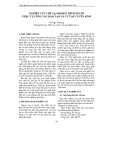

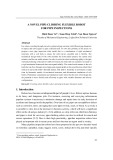
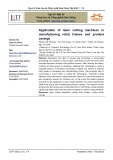

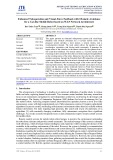
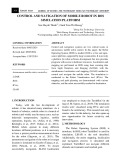

![Đề cương đề tài nghiên cứu khoa học [chuẩn nhất/mới nhất]](https://cdn.tailieu.vn/images/document/thumbnail/2025/20251117/duong297/135x160/26111763433948.jpg)










